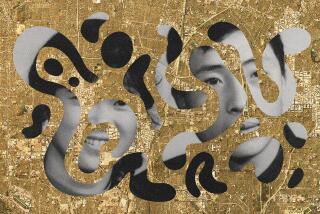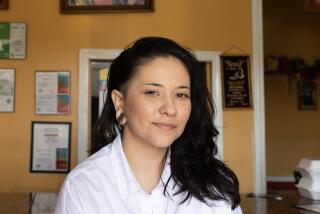Immigrants Fertile Soil for Mennonites
It was shortly after 2:30 p.m. on a recent Sunday, and about 100 people, mainly immigrants from Indonesia and their children, had gathered for their weekly worship service in a small, borrowed church building on a tranquil tree-lined street in Sierra Madre.
For the next two hours, members of Jemaat Kristen Indonesia Anugerah, or the Grace Indonesian Christian Fellowship, sang and prayed exuberantly in Bahasa Indonesian and English. They also heard two sermons: one from their regular Indonesian pastor, the Rev. Virgo Handojo, and a second, shorter one from their bishop, the Rev. Jeff Wright of the Pacific Southwest Mennonite Conference.
Such congregations shatter the stereotype of Mennonites as white, Pennsylvania Dutch believers who worship quietly and keep to themselves. And the Indonesian church illustrates the success of the Protestant denomination in attracting recent immigrants from Asia, Africa and Latin America to its once mainly white congregations.
The Mennonite church had been in such decline in this region that by 1985, “conventional wisdom among seminarians of the day was that Southern California was a wasteland,” Wright said. But since then, their local ranks have more than doubled to about 2,700, and 94% of local Mennonites now are Asian, African or Latino, he said.
Their worship styles are as different as their cultures and languages, but all maintain the Mennonites’ commitments to pacifism, social justice and charity. Many Mennonites decline to serve in the military and become conscientious objectors. Many expressed opposition to the U.S. invasion of Iraq.
Jemaat Kristen was founded five years ago by Handojo, who started churches in his native central Java after a dramatic 1979 conversion from Javanese mysticism to Mennonite Christianity.
“My philosophy in building a multicultural congregation is that we should maintain the identity of each person, but at the same time encourage them to actively relate to each other’s cultures,” said Handojo, 48.
Wright oversees 32 churches and eight developing congregations in Southern California, all part of the Mennonite Church USA, the nation’s largest Mennonite body. He says being a Mennonite isn’t about having a “certain German ethnic character that fits in Pennsylvania.”
“It’s about holding a set of values around Jesus being at the center of our faith, the church being at the center of our life, and reconciliation, peacemaking and justice being in the center of our work,” he said. “If we hold those values, it doesn’t matter whether we have high liturgy or wear funky hats. The good news is that the church is multiethnic, and what unites us is a common set of values around who Jesus is.”
After the service at the Indonesian church, attendees chatted into the evening over a dinner of shrimp chips, rice cooked in coconut milk, salty fish with peanuts, spicy beef and tea.
“My church is not just a place I come for spiritual worship,” said Tom Courtney, a Tustin businessman who is among a handful of non-Asians in the congregation. “It’s also my social life.” It’s his extended family too, a community he can count on, he said.
Ratna Hoag, whom Handojo baptized in 1999, drives 120 miles round-trip from her Irvine home every Sunday to attend church, because it feels “so homey” to be with so many fellow Indonesian immigrants.
“It’s worth the effort,” said the ethnic Chinese from Jakarta. “They help me a lot.” She calls Handojo and his wife, Jeanne, role models for her spiritual walk and marriage.
Compared to other denominations, Mennonites are a small group: a little more than 1 million worldwide, 200,000 of those in the United States spread among various Mennonite groups.
Advocates of nonviolence and community work, Mennonites believe in a life centered on Jesus’ teachings -- focused on living simply, shunning ostentation and giving generously to people in need.
U.S. Mennonites raised $12 million for tsunami victims in South Asia, and volunteers from the denomination worked in stricken areas through the Mennonite Central Committee, the relief arm of the church.
Many Mennonites rent places to worship, because acquiring property is not a priority. The Indonesian church, for example, uses a Congregational church building and makes donations in return.
None of the pastors receive full-time pay, Wright said. They usually work at another job to support their ministry.
Mennonites, named after Dutch priest Menno Simons, trace their religious heritage to Christians known as Anabaptists. They were persecuted during the 16th and 17th centuries in Europe for believing in the separation of church and state and in adult, rather than infant, baptism. Many of those “re-baptizers” fled to Russia, the United States, Canada and Central and South America, and formed various sects.
Mennonites are sometimes confused with their Amish cousins, known for their plain dark clothing, horses and buggies, and shunning of modern technology. But the Amish split from the Mennonites in the 1700s, because they believed that the larger group was too involved in the world.
Mennonite missionaries from Holland traveled to Indonesia, then a Dutch colony, in the 1850s, according to Juan Martinez. He is a professor of Hispanic church studies at Fuller Theological Seminary in Pasadena and an ordained minister in the Mennonite Brethren Church, another major Mennonite body.
Mennonites’ growth in California has been most pronounced among immigrants. In the Central Valley, for example, nearly half of Mennonite churches have Latino congregations, Martinez said.
Of the Southland, Bishop Wright said: “You can’t do ministry in Los Angeles and ignore immigrants.”
Among the churches he supervises is Los Angeles Faith Chapel in Inglewood. It is a congregation predominantly of immigrants from West Africa who incorporate lively African music and dancing into their 11 a.m. Sunday service. Nigerian-born pastor Chuwang Pam also encourages work with the homeless.
Every Sunday morning, an associate pastor drives a 12-seat van to skid row to pick up homeless people, take them to the service and offer them meals, clothes and counseling at the church.
Femi Fatunmbi is pastor at Royal Dominion Family Chapel, a South Los Angeles congregation primarily of Africans, South Americans and African Americans. He is a former Nigerian civil servant and a former Anglican who came to Los Angeles in 1994 with his wife, Shade, to be missionaries here.
“We are redefining who the Mennonites are,” Fatunmbi said. “It used to be North Americans and Europeans that would go down to Africa for mission work. Now, you see [that] a lot of Africans are coming to America for mission.”
More to Read
Sign up for Essential California
The most important California stories and recommendations in your inbox every morning.
You may occasionally receive promotional content from the Los Angeles Times.










